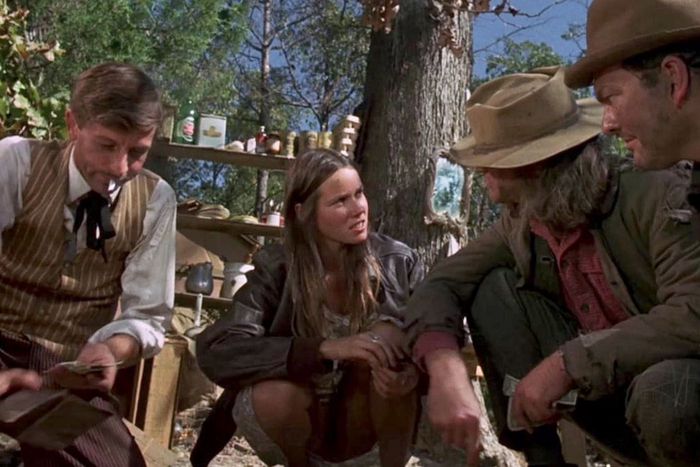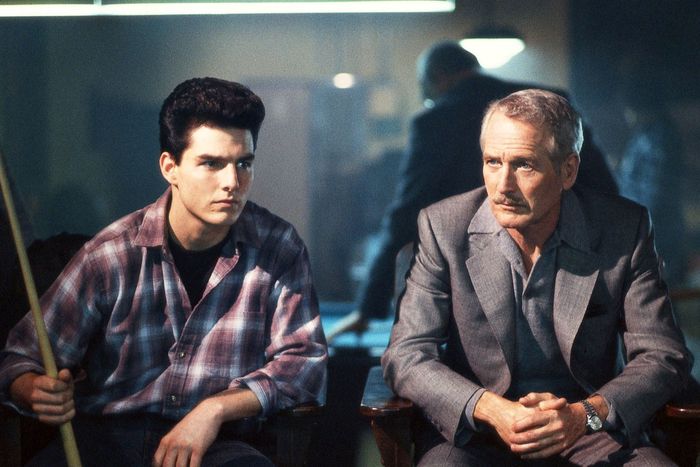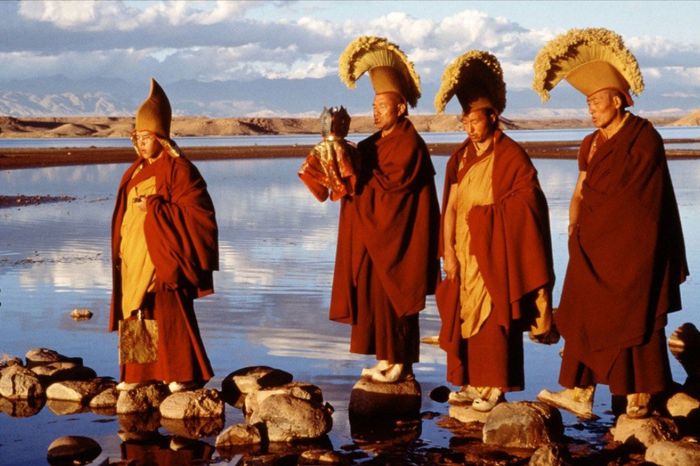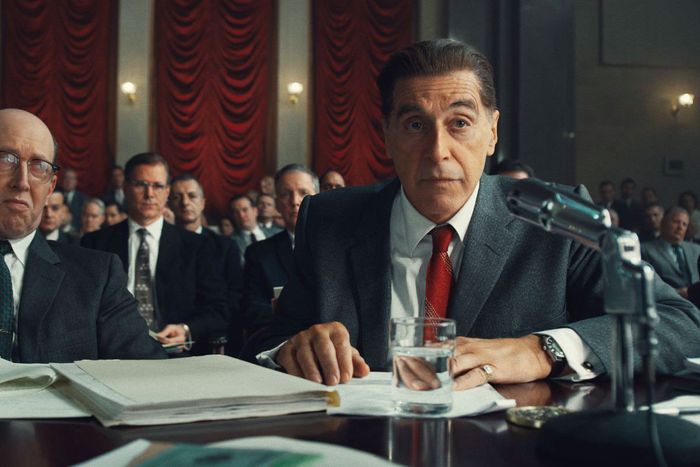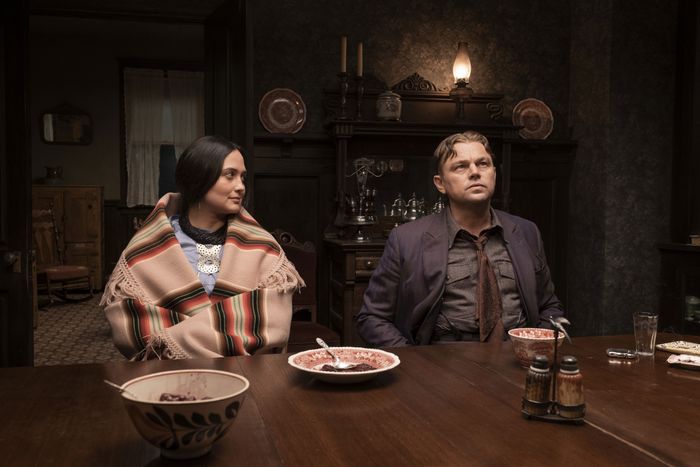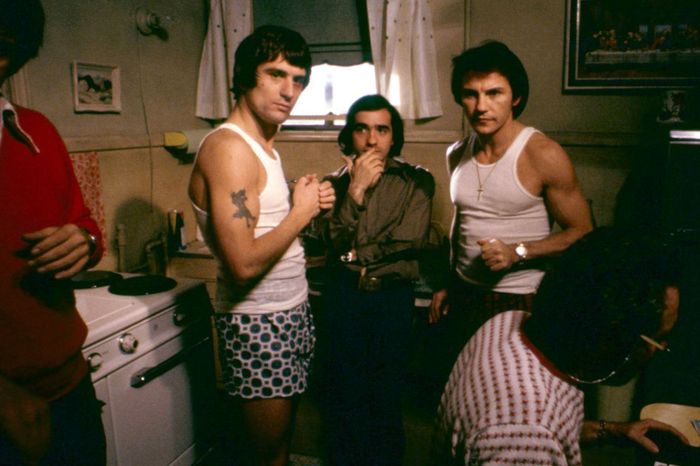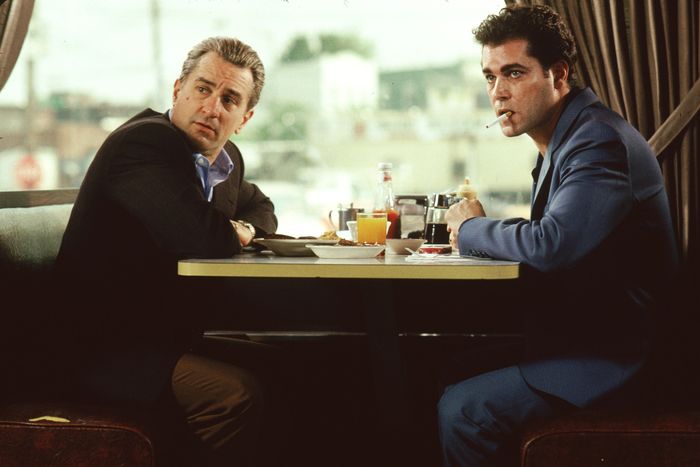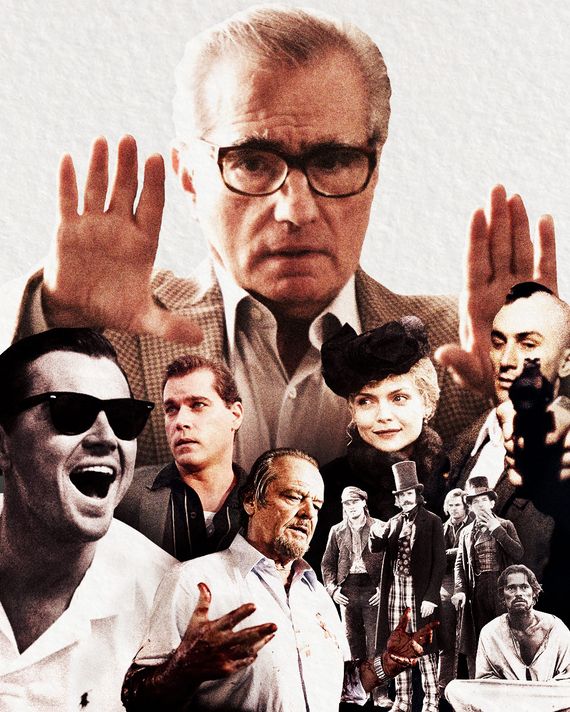
This article was originally published on October 31, 2019. It was updated to include Killers of the Flower Moon, which is now available to stream on Apple TV+.
When Martin Scorsese decided he wasn’t going to be a priest, his reasons were simple. “I began to think this vocation I had was for the wrong reasons — it shouldn’t be about you,” he explained to critic Richard Schickel in the excellent book Conversations With Scorsese, “it should be about others.” Plus growing up with asthma and unable to play sports, he wasn’t sure he wanted a life that would add to his isolation. “[I]t was going to be about cutting myself off from the world,” he said of becoming a man of the cloth, “not being a participant in it.”
In the best sense, Scorsese’s movies have always been about him — passionately, deeply personal works that catalogue his hang-ups and obsessions, riffing on religion, spiritual torment, guilt, and the difficult road to transcendence, often through gangster pictures and crime dramas. And although he remains one of the most movie-obsessed of all directors, his films rarely feel like the work of a man cut off from the world — quite to the contrary, they’re fully engaged with their specific milieus, whether Tibet or Little Italy. His movies feel alive, inviting — even when his characters are mobsters or monsters. They’re the work of a true believer.
That devotion inspires an equally rapturous following, and as such, it’s probably best to warn you now that our rankings of Scorsese’s films will not perfectly overlap with your own list. Because his films are always made with care and near-religious fervor, even his weakest have their selling points — he has as many classics as overlooked masterpieces, and no two people will agree on which are which. So, with Killers of the Flower Moon now in theaters, we present our rundown of the Oscar winner’s best and worst films. (One note: We didn’t include his HBO documentaries or A Personal Journey With Martin Scorsese Through American Movies or My Voyage to Italy.) As you’ll see, there’s very little “worst” here — more like ambitious misfires or imperfect curiosities. Thank heavens Scorsese rejected the priesthood and followed a higher calling.
30. Boxcar Bertha (1972)
Gene Siskel, who was prone to flights of moral panic about violence in movies, was disgusted with Boxcar Bertha, calling it “trashy.” Scorsese’s second movie is a little trashy, we suppose, compared to what he’d do later, but considering this is a Roger Corman production, trash is just the starting point … and what Scorsese is trying to work around. It’s a noble effort and features a terrific lead performance from a 23-year-old Barbara Hershey, but this is essentially an audition reel for Scorsese to show what he could do if he ever got to do a real movie.
29. Shine a Light (2008)
The Rolling Stones’ music has long been the soundtrack to Scorsese’s movies, so it’s little surprise that when he finally got around to making a movie about the band, it would be a reverential document, a movie for longtime fans from a longtime fan. This concert film is slight — it doesn’t have the benefit of capturing a moment in musical history like The Last Waltz — but, especially in its original Imax presentation, Shine a Light is fairly compelling evidence that the Stones remain stunning physical specimens, capable of embodying a rock-star spirit that’s equal parts magisterial and strutting. It’s a film made by an old pro about some other old pros — fellow soul survivors, you might say.
28. New York, New York (1977)
After the revelation that was Taxi Driver, critics and audiences were initially baffled that Scorsese’s follow-up would be … an old-timey musical tribute to the golden days of Hollywood? New York, New York was famously a massive flop and one that Scorsese has long attributed to his collapse into cocaine addiction. But seen years later, well, Marty should have taken it easier on himself. The movie is spotty and odd and never really gels into a coherent whole, but it’s still full of enrapturing moments, and it feels far more in keeping with Scorsese’s career today than it did on the heels of Taxi Driver. New York, New York is obviously lower-tier Scorsese, but if a first-time filmmaker had made this, they’d have all called him a budding genius.
27. The Color of Money (1986)
It ended up winning Paul Newman his long-overdue Oscar, and the film often feels like it exists largely for that reason. The Color of Money feels slicker, more self-consciously “mainstream” than we’re used to from Scorsese, for good reason: The project was Newman’s, not Scorsese’s, and this is as close as he’d ever get to being a hired gun. Had he gone in that direction for his career — and thank God he didn’t — he would have been brilliant at it: The movie is crackerjack entertainment, Scorsese bringing life to a familiar story and a generally conventional narrative. The movie feels like Scorsese impersonating a lesser but still talented filmmaker, which makes it disorienting to watch, if not necessarily unpleasant. This remains the only Scorsese film to ever receive “Two Thumbs Down” on Siskel & Ebert.
26. New York Stories (1989)
A filmmaking exercise featuring three shorts about characters in New York City by the three most accomplished American directors at the time (Scorsese, Francis Ford Coppola, and Woody Allen) ends up playing today like a competition between the three … and Scorsese wins rather handily. His story of a passionate, self-destructive painter (Nick Nolte) whose work is fueled by romantic discord with a series of younger, tempestuous lovers feels a little problematic today. (You want to tell these women working as his assistant to get the hell away from this jerk and then sue him.) But Scorsese’s comfort with the material is self-evident. Allen’s film is the usual; Coppola’s is dull and precious. Scorsese’s is the only one that burns with life.
25. Bringing Out the Dead (1999)
Nicolas Cage, even at his peak, never was a Scorsese type of actor: When he dials it up, he tends to underscore too much, or even undercut, what a director of Scorsese’s level of control is trying to go for. Cage can do haunted, and he can do manic, but balancing the two well is something he’d be better at in Mandy 20 years later than he is here. This movie, scripted by Paul Schrader in another lone-man-going-mad-in-a-mad-world descent into hell, never quite settles on a consistent tone. The film isn’t bad, exactly, and neither is Cage, but it never comes together the way you can sense Scorsese wants it to.
24. Rolling Thunder Revue (2019)
Scorsese’s other 2019 Netflix film is a pseudo-documentary about Bob Dylan’s notorious 1975 concert tour that Dylan himself once wrestled into a mostly unwatchable fictional film called Renaldo and Clara. Scorsese uses the footage from the tour, which is still breathtaking 40 years later, and splices it to a series of interviews with Dylan and other members of the tour … along with, it turns out, various actors (including Sharon Stone) playing entirely fictional characters supposedly connected to the tour. Scorsese has a grand time playing around with Dylan’s messing-with-the-legend aesthetic, even if Scorsese is not, at heart, much of a prankster. But he does find the soul of the tour and, intriguingly, even Dylan, with an ending that’ll come out of nowhere to surprise you with its warmth and even its triumph.
23. Kundun (1997)
Of Scorsese’s films about faith, Kundun is the least persuasive — although it might be the most immersive and visually enrapturing. Working with cinematographer Roger Deakins and composer Philip Glass, Scorsese presents the life of the 14th Dalai Lama (four different actors play the role at different ages) as he journeys to fulfill his spiritual destiny — at the same time that Tibet’s independence is threatened by China. “[W]e wound up cutting the picture purely on an emotional level, almost like a documentary, so that we shuffled around scenes that were shot for other sections of the picture and also in different locations,” Scorsese said at the time. “And what worked more for us were the dreamlike states rather than narrative scenes.” As a result, Kundun is a movie that delights the ear and the eye — it’s surpassingly beautiful to behold — but doesn’t entirely crack the man or the complexity of his beliefs. It’s a depiction of the mystery of faith that ends up being a little too opaque to fully connect.
22. Who’s That Knocking at My Door? (1967)
Martin Scorsese was about to turn 25 when his debut had its world premiere at the Chicago Film Festival. Who’s That Knocking at My Door? is very much the film of a young director who’s working through his influences, trying to find his own voice. And yet, it’s pure Scorsese: Harvey Keitel plays J.R., a guy who lives to hang out with his buddies when he’s not trying to hook up. Then along comes a beautiful, unnamed girl (Zina Bethune) whom he wants to marry — until she tells him a terrible secret. The Madonna/whore complex that would play out in later Scorsese pictures such as Raging Bull received its first airing here, as would the director’s obsessions with guilt and lust. It’s a raw, vital film that underground New York auteurs such as John Cassavetes deeply dug. They hadn’t seen nothing yet.
21. Hugo (2011)
This adaptation of the Brian Selznick children’s book arrived at the zenith of the 3-D craze, just two years after Avatar, but Scorsese made sure to put his own little stamp on the format. Hugo is dizzying and playful in a way Scorsese likes to indulge in from time to time, and his heart is deeply invested in Ben Kingsley’s Georges Méliès, one of the characters you sense is among Scorsese’s most autobiographical. The movie is indulgent, but never to a fault, and although it won five Oscars, Hollywood will surely never let him make another 3-D film — this is one of the biggest financial failures of his career.
20. Gangs of New York (2002)
A movie that’s now often overshadowed by the hell that went into its making — Scorsese called the shoot “nightmarish” in Conversations With Scorsese — Gangs of New York is a good historical epic that’s not great enough to transcend the drama swirling around its production and Oscar campaign. (The shoot was long and expensive, and Harvey Weinstein essentially tried to guilt the Academy into giving Scorsese his first Oscar.) What you’re left with is Leonardo DiCaprio’s uneasy first collaboration with Scorsese (everything he’s done with the director since has been better), in which he plays a tough Irish kid swearing to get vengeance for his slain father, and Daniel Day-Lewis as the monstrous Bill the Butcher. A sort of origin story for the mobster lifestyle that Scorsese has chronicled in plenty of films, Gangs of New York is a fascinating, often compelling mess that swaggers with ambition and is undercut by myriad tiny deficiencies. (Like DiCaprio, Cameron Diaz feels ill at ease as his tough-as-nails love interest.) Still, it’s a feat of production design and vision, even if Scorsese’s reach exceeds his grasp.
19. Silence (2016)
Scorsese had essentially been attempting to make Silence for his entire career, and watching it, you can see why he had such difficulty talking anyone into giving him the money to make it. This movie is a long, grueling journey of faith and pain about two priests (Andrew Garfield and Adam Driver) on their own journey of faith and pain. Silence is about enlightenment borne of strife and torture, and it can feel that way at times, which is Scorsese’s intent. But where it lands, and where we all end up in the story, with the emergence of the priest’s mentor (Liam Neeson), ends up being worth how far they (and we) had to go to find him — even if the lessons he ultimately teaches feel decidedly less than purifying.
18. The Last Temptation of Christ (1988)
The blasphemy heard round the world, this adaptation of the Nikos Kazantzakis novel dared to depict Jesus as a deeply human individual, filled with a preternatural kindness and humility but also tempted to abandon his holy mission and run away with Mary Magdalene (Barbara Hershey). The Last Temptation of Christ is, to date, Scorsese’s only collaboration with Willem Dafoe, who would seem like an ideal actor for the director’s impassioned, tortured aesthetic. Nevertheless, Dafoe made this one count, playing Jesus as a mortal who aspires to live up to God’s image — “He wanted to bring it back into the body of a man and I felt like I was ready to do that,” Dafoe said later of Scorsese’s take on Christ — and while the film has its weaknesses and uninspired segments, what comes through is the director’s genuine spiritual searching, his deep admiration for the momentousness of Jesus’ quest. Plus it has one of Scorsese’s most moving finales, a true reckoning.
17. Cape Fear (1991)
Scorsese’s remake — originally Steven Spielberg was going to make it; he wanted to cast Bill Murray as Max Cady! — turns a traditional legal thriller into something scary, twisted, and at times thrillingly revolting. This is Scorsese in Hitchcock mode, but he’s too singular a filmmaker to do some sort of Brian De Palma–esque homage; he finds the pain and the sickness in not just De Niro’s Cady but the lawyer Sam Bowden (Nick Nolte) and his family. De Niro has the showiest performance, and you can sense him and Scorsese having fun just making a big Hollywood thriller this disturbing. It’s not the finest art of Scorsese’s career, but many of its images will last forever alongside some of his greatest films. And it led to one of the greatest Simpsons episodes ever.
16. The Last Waltz (1978)
In Peter Biskind’s juicy 1970s-Hollywood book Easy Riders, Raging Bulls, Scorsese’s former girlfriend, writer Sandra Weintraub, famously commented, “It was a shame that Marty wasn’t gay. The best relationship he ever had was probably with Robbie.” She means Robbie Robertson, the leader of the Band, and the two men’s platonic love affair was never more evident than in The Last Waltz, which commemorated the group’s blowout final concert on Thanksgiving 1976. The Band invited peers and influences to play alongside them — Neil Young, Van Morrison, Muddy Waters, Eric Clapton, Ronnie Hawkins, Bob Dylan, Joni Mitchell, Neil Diamond — and Scorsese’s cameras captured not just the performances but also the sense of one rock-and-roll era fading away. If that sounds terribly sentimental, well, that’s the beauty and limitation of The Last Waltz, which doubles down on the sap by having Robertson and his band mates wax lyrical in separate interviews about the spiritual toll of touring and the power of music. If you buy into the malarkey, the movie is simply marvelous — and even if you don’t, the renditions of Band classics are almost uniformly spectacular, as are those from their buddies. Even Neil Diamond slays.
15. Alice Doesn’t Live Here Anymore (1974)
Is Alice the most fully realized female character in any of Scorsese’s films? That it’s a distinct possibility is both an indictment of Scorsese’s career and a recognition of how perfect a character Ellen Burstyn and Scorsese created in his first Hollywood movie. Alice Doesn’t Live Here Anymore feels both fussed over and lived in. It’s remarkably assured, confident, and sensitive from a filmmaker who had just the year before made a film about Catholic guilt, misogyny, and rage. Up to this point, Scorsese looked like a future star. Now it appeared he was capable of anything.
14. After Hours (1985)
In a sense, After Hours is a movie about how Martin Scorsese couldn’t get his then-dream project, The Last Temptation of Christ, off the ground. Frustrated, he decided to blow off steam by working on a down-and-dirty dark comedy about a working stiff (Griffin Dunne) who gets sucked into a surreal night of beautiful women, dangerous men, and weird farce. “I thought it was a whole metaphor for the way we are living and for what I went through in L.A. trying to get The Last Temptation made,” Scorsese once said. “I just had a ball with it, because it meant so much to me. I asked myself, ‘Can I make a picture with the same energy I had when I was 32?’ And I did.” He was 42 when After Hours came out, and after years of aborted projects and commercial disappointments (The King of Comedy), this film felt alive and dangerous — the work of a director who, quite simply, just wanted to make a picture. Its giddy punk-rock purity remains intoxicating.
13. The Age of Innocence (1993)
An Edith Wharton costume drama would seem the opposite of Scorsese’s inclinations, but as usual, if you thought Scorsese was just about gangsters and violence, that said more about you than it did about him. Scorsese realized that passion disguised and repressed — like in the case of the crushed, devastated Newland Archer (Daniel Day-Lewis, in one of his most underappreciated performances) — can be as emotionally violent as the blood spurting out of Jake LaMotta’s eye. And Scorsese’s famous attention to detail has never looked so lush and luxurious: Everything is so beautiful and exquisite that it just accentuates how raw and aching the characters are underneath it all.
12. The Wolf of Wall Street (2013)
Rampant exposure to this movie on cable suggests that Scorsese’s bilious portrait of Jordan Belfort may soon join GoodFellas as one of the director’s most intensely rewatchable efforts. And like with GoodFellas, that evergreen entertainment value doesn’t mean Scorsese admires the denizens he’s chronicling. The Wolf of Wall Street is a three-hour deep dive into greed and arrogance, removing the moral guardrails that usually insulate viewers so that we can fully appreciate (and be horrified by) the sickening, atrocious overindulgence on display. DiCaprio is glorious as Belfort, an absolute prick before he’s rich and even more of one afterward. Meanwhile, Scorsese utilizes his old tricks — rocking soundtrack, swirling cameras, multiple voice-overs — to unearth a Wall Street ecosystem that’s immune to the laws and ethics that the rest of us have to obey. (Kyle Chandler is the one glimmer of decency in the film. Watch how shabbily he’s treated.) Sometimes, the film’s examination of excess can simply be excessive, but The Wolf of Wall Street is hypnotizing — and a damning condemnation of us poor rubes. We’re all those suckers at the end of the movie, trying to sell Belfort a pen.
11. The Aviator (2004)
Another project that was batted around from director to director — including Michael Mann, Milos Forman, and Christopher Nolan — ended up in Scorsese’s hands, and he of course made it feel like it was his all along. This story of Howard Hughes in his young, bon vivant days, when he could hide his OCD and become one of the wealthiest, most famous men in the world, has a deep compassion for its main character, and The Aviator truly soars during his aviation scenes, which both pay homage to Hughes’s earliest films and create something altogether new about them. The scene where Hughes crash-lands through Beverly Hills remains jaw-dropping, but Scorsese’s grandeur and bravura action sequences never take away from the focus on the proud, doomed man at its center. This is the director doing a big-budget, star-laden, big-tent biopic that nonetheless feels uniquely his, a Hughes that’s both larger than life and yet painfully human-sized. It’s Scorsese once again making a film that no other filmmaker could pull off, and making it look impossibly easy.
10. The Irishman (2019)
We never entirely bought the argument that Scorsese glamorized the mobster lifestyle. Sure, he understood that these men were charismatic and compelling, but they often met morbid fates; they rarely walked off into the sunset. That deep ambivalence toward the criminal underworld has always made his movies resonate, giving off a vicarious thrill while also humming with moral uncertainty. Lest there be any doubt, The Irishman makes it plain: Crime does not pay. Over three and a half hours, he and screenwriter Steven Zaillian turn Charles Brandt’s book I Heard You Paint Houses into a near-definitive word on organized crime, and it paints a despairing portrait.
Robert De Niro is Frank Sheeran, a small-time driver who will work his way up the ladder, eventually becoming close friends with Jimmy Hoffa (Al Pacino). Nearly everyone in The Irishman is a dead man just waiting to die — we’re introduced to supporting characters with an interstitial telling us when and how they buy the farm — and the film’s poignancy is mixed with a clear-eyed certainty that these individuals do not deserve our sympathy. Scorsese films are rarely elegiac, but Sheeran serves as not just an entry point into the mob but also a way to understand that there are no heroes — or anti-heroes — among this den of thieves. The final shot leaves the door open to multiple interpretations, but what’s obvious is that this director and some of his prized collaborators — including Harvey Keitel and Joe Pesci — have marshaled their forces for a knockout farewell.
9. Shutter Island (2010)
Poor Teddy. Scarred by World War II, mourning a dead wife, tormented by migraines, he’s a U.S. Marshal trying to figure out how a mental patient could go missing in a heavily guarded hospital on a remote New England island. But nothing will be easy for Teddy and his new partner, Chuck — especially when Teddy’s grip on reality starts to waver. This is the sad story of Shutter Island, a movie, we humbly submit, that is even more emotionally devastating after you know what the story’s big twist is. Repeat viewings heighten this tale of grief and willful delusion, and DiCaprio is a knockout playing a man investigating others so he can avoid investigating himself. Drawing from avant-garde composers like John Adams and Max Richter, Scorsese crafts a psychological horror movie that’s also a piercing tragedy, all the while delivering a portrait of postwar anxiety right up there with The Master. Shutter Island is knowingly old-fashioned and yet bracingly modern, a snapshot of PTSD and extreme trauma disguised as a juicy B-movie. “Which would be worse,” Teddy asks his partner, “to live as a monster or to die as a good man?” Unfortunately, Teddy is going to find out.
8. The Departed (2006)
At the time, it seemed insane, even a little offensive, that of all the movies Scorsese would finally win his Oscar for, it would be this, a grisly, sleeves-rolled-up slick crime thriller that featured all the excitement of a Scorsese gangster picture without much of the dread and guilt. Yet the years have been kind to The Departed, a film that basically does at the highest level what thousands of thrillers have been trying to do for decades; Scorsese pulls it off without really breaking a sweat. Sure, Jack Nicholson dials it up a little high, and yeah, not everyone is in agreement about the controversial last shot, but The Departed is the film every tough-guy Tarantino-wannabe would kill his mother to make. About to turn 64, Scorsese made the best possible version in his sleep.
7. Killers of the Flower Moon (2023)
Originally, Scorsese and co-writer Eric Roth had focused far more on adapting the “birth of the FBI” aspect of David Grann’s 2017 bestseller Killers of the Flower Moon: The Osage Murders and the Birth of the FBI. (He was even going to have Leonardo DiCaprio play the FBI agent investigating the murders — what ultimately became the Jesse Plemons role.) But he realized, during COVID, that he was looking at the story all wrong. “The real story, we felt, was not necessarily coming from the outside, with the bureau, but rather from the inside, from Oklahoma,” Scorsese said. It was, fair to say, the right call. What could have been an expert, but familiar, procedural becomes something far more personal, an epic story about American ambition, corruption, and cruelty that also has perhaps the most fascinating and devastating love story at its center. All the major themes of Scorsese’s career are here, but there’s a perspective here, a quiet, almost humble remove, that sets this apart while still keeping it vibrant, urgent, and in the end, downright furious. Sure, the movie is extremely long, but it doesn’t feel that way when you’re watching it: You’re so enveloped in this world that you begin to feel a part of — implicated, even. Lily Gladstone’s Mollie instantly becomes one of Scorsese’s most complicated, complex characters, but you feel Scorsese’s despair in Robert De Niro’s “King” Hale, a man who believes he can get away with anything and therefore does — revealing himself as an essential aspect of the American character. Made when Scorsese was 80, the film is electric, hypnotic, and relentlessly entertaining, but it’s also deeply sad and heartfelt in a way that could only come to Scorsese this late in life. By the time an unexpected — and almost overwhelmingly powerful — cameo catches you by surprise at the end, you’ll be bowled over. It’s pure Scorsese … but also a lot more.
6. Casino (1995)
Occasionally, a film gets unfairly penalized because it reminds viewers of an earlier, better movie from the same director. Take Casino, which was dinged because it arrived so soon on the heels of GoodFellas: What, another big portrait of organized crime with Robert De Niro and Joe Pesci? The film is so good that it’s weathered those criticisms. Scorsese explores the wheelings and dealings of Las Vegas through the eyes of a buttoned-down mobster (De Niro), whose studious approach can’t keep disaster from his door. There are obviously similarities to GoodFellas — Pesci, as De Niro’s pal, seems to be trying to outdo his Oscar-winning performance from that previous film — but Casino’s epic sweep is even more ambitious. And GoodFellas didn’t have a character like Ginger McKenna, a hustler who proves just as conniving as the men around her. Sharon Stone was never better than she is here, joined by James Woods as one supremely sleazy lowlife. GoodFellas is superior, but this operatic drama isn’t far off.
5. Mean Streets (1973)
When Mean Streets came out, Roger Ebert claimed that Scorsese could become the American Fellini within a decade. Legendarily, when Scorsese met Ebert soon after, he asked the critic, “Do you really think it’s going to take ten years?” That turned out not to be Scorsese’s trajectory — he’s too much of an original to be the American anybody — but watching this 1973 film, you can understand what Ebert meant. Mean Streets is Scorsese’s version of I Vitelloni, Fellini’s early semi-autobiographical drama about a group of young men figuring out their lives. Here, it’s two small-time crooks, tormented Charlie (Harvey Keitel) and loose cannon Johnny Boy (Robert De Niro), who live at the margins of the New York mob world. Keitel and De Niro are impossibly young, and yet they’re both fully formed, conveying (respectively) the angst and volcanic fury that would be their trademarks. The Scorsese of Mean Streets is dipping his toe into the themes that came to define his career — violence, Catholicism, guilt — with a pungent urgency that would be refined and examined more deeply in later projects. Mean Streets was a revelation at the time; in retrospect, it merely feels like the rich first chapter of the great book that is his career.
4. The King of Comedy (1982)
For years, this thorny, proudly unlikable little dark comedy was the go-to Scorsese movie to pick as his most underrated. (It didn’t do great business and wasn’t particularly beloved by critics at the time of its release.) Unfortunately for our society, though, The King of Comedy continues to be depressingly relevant, a journey through the mind of an unstable aspiring stand-up who just knows that legendary talk show host Jerry Langford (Jerry Lewis) would love him if he just got to know him. A movie inspired by an era in which a Beatle was murdered in New York City, Scorsese’s film continues to speak to our times, which are awash in celebrities and those desperate to become them and consume them, even destroy them. De Niro plays Rupert Pupkin like a walking embarrassment, while Scorsese moves from reality to delusion with alarming ease. Showbiz has never really looked so pathetic — the movie is funny, but it’s rarely haha funny.
3. Raging Bull (1980)
It’s easy to see this movie as the apex of a certain kind of tortured-male cinema: The lead actor gained a ton of weight for the role, the director was working through a spiritual crisis, and the subject was a, yes, raging bull whose athletic prowess couldn’t quell his many personal flaws. For decades now, filmmakers have been chasing the raw brutality Scorsese brought to Raging Bull’s boxing scenes — they remain poetic and horrific works of art. As for De Niro, he transformed himself into a caged beast, a chest-thumping savage who only finds some sort of peace when he’s beating someone’s brains in or having someone do it to him. Any “dark” character study that came after Raging Bull, any remotely sobering sports biopic, has to contend with this movie’s long shadow. It is a very hard movie to love, but it’s impossible not to be pummeled by its intensity and its stubborn belief that anybody, even Jake LaMotta, deserves redemption.
2. Taxi Driver (1976)
Taxi Driver, like its protagonist, has always felt too real. Its nightmarish vision of New York as a hell that just needs a rain to come down and wash all the scum off the sidewalks is so fully realized that the city has been portrayed alternately as the most horrible and the most wonderful place on earth ever since, as if to either steer into or overcompensate for Scorsese’s depiction. DeNiro, who actually spend time driving a taxi alone at night to prepare for the role, plays a Travis Bickle who is disturbed and anguished in a way that’s so plainly on the surface that it’s almost too painful to even look at: He’s dangerous in a way that not even he can quite understand. In Bickle, he and Scorsese gave us the sort of lonely, embittered, angry, sadistic, lost young man that we see around us every day, one that exists in every culture — figures not yet fully formed, bombs ready to go off. And with its denouement, which undercuts and recontextualizes everything that came before it, the film provides an altogether new hellscape that feels more familiar with each passing day. Taxi Driver is almost more filmmaking power than one man should have.
1. GoodFellas (1990)
Like many certified classics, GoodFellas has been so absorbed by the culture that it now runs the risk of being simplified in our collective consciousness as just a collection of memorable quotes, stylish flourishes, and striking visuals: the “Layla” death montage; “I’m funny how?!?”; the Copacabana tracking shot; the “Jump Into the Fire” sequence of Henry Hill’s terrible, horrible, no good, very bad day. Watch GoodFellas again, though, and you’ll be amazed how absorbing and nuanced the whole thing is — how its depiction of an aspiring mobster (Ray Liotta) is a blueprint for the American Dream that’s been distorted and corrupted. Draining away The Godfather’s pulp pleasures and providing the DNA (and many cast members) for The Sopranos, GoodFellas never forgets that, deep down, crooks love the lives they lead, and so the movie is also fiendishly entertaining and funny — until it isn’t. Scorsese has never hidden the fact that he grew up with guys like Hill, and that he always admired them, even though he knew he probably shouldn’t. He works through those conflicted feelings brilliantly in GoodFellas. All these years later, all of us remain just as torn about these enormously charismatic reprobates.
Grierson & Leitch write about the movies regularly and host a podcast on film. Tim Grierson is the author of Martin Scorsese in Ten Scenes. Follow them on Twitter or visit their site.


